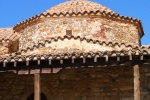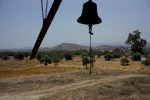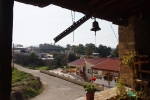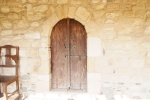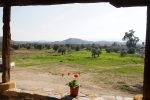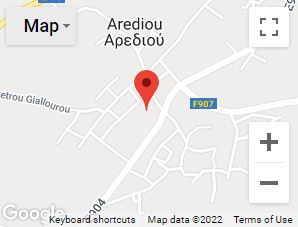Church of Agios Georgios
The main church of the village is dedicated to Agios Georgios and is located in the centre of the village.
It is a single-room church with 20th century groin vaults. The church is 11.30 m wide and 26.40 m long, while the chancel was built in 1945 by Fylaktou K. Taliadwros from Omorfita.
In fact the church was built to replace a smaller church which had been demolished so that the present church would be constructed in its place. The only remains of the older church are the chancel, which is now kept in the church of Agioi Iliofotes located at the deserted village of Agioi Iliofotes, an icon depicting Jesus’ entry to Jerusalem, as well as some utensils used during the mass.
Its construction began in 1908 and was completed in 1915. The inauguration ceremony was held on May 2nd 1921. The people responsible for the construction of the church were Father Papavarnavas Hadjipetri and cashier Michalis Michael (Michaeloudi), while the two builders were called Nikolas Milopittas and Costas Hadjipieris. What is noteworthy is that all the residents of the village helped build the church voluntarily by working every other week as assistants of the builders or as material transporters. Even women helped construct the church by using their aprons to transfer stones from the Koutis river.
Georgios Panagis adds the following: According to a testimony by Nikolas Thoma Pitsillou, which has been preserved by Papapetros Fotiou, while the church was being built a group of wine traders stopped by the church coming from Palaechori. As usual they worshipped the icon of Agios Georgios and left some money in the church before leaving. However, one member of the group did not leave any money saying “Agios Georgios, you don’t need any money”. Half a kilometre further down, as soon the traders reached “Liochora” their barrels were perforated and their whole wine spilled. After that incident he went back to the church and left some money in the Saint’s box saying “Agios Georgios, I was joking but you were not”.
*Source:
This text has been prepared based on the questionnaire answered by Mr Georgios Panagi.
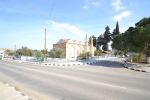
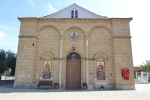
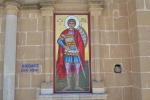
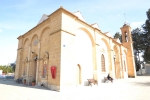
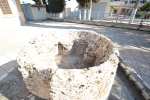
Chapel of Panagia Odigitria
The church of Panagia Odigitria is located half a kilometer east of the village and is dated back to the 13th century. According to tradition, the church was constructed on the ancient ruins of an idol worshipping temple.
It is a single-room church with a dome which was renovated in the 1980s by the Department of Antiquities. The church is approximately 6.80 metres wide and 13.20 metres long.
The interior of the church is adorned by 13th, 14th and 15th century hagiographies, as well as by an elaborately carved chancel dated back to the 17th century. According to Georgios Panagi, “the southern wall of the main church carries two superpose layers of hagiographies depicting Virgin Mary and Jesus Christ which are dated back to the 13th and 14th century respectively, whereas the northern wall is adorned by a hagiography of Agios Georgios which is dated back to the 15th century. Parts of hagiographies, mainly plant decoration, are salvaged on the walls of the main church and on the lower part of the arc’s internal wall of the sanctuary”.
Finally, it is worth mentioning a series of traditions which are linked to the church of Panagia Odigitria and which have been recorded by Georgios Panagi* as follows:
Tradition has it that Virgin Mary sat at the place where the church is located to take a rest while She was passing by the village.
According to another tradition preserved by Father Papapetros Fotiou, the King of Tamasos’ daughter, Aretou, used to visit Arediou and offer a sacrifice at the temple which existed there before the church of Panagia Odigitria.
Another tradition mentions the existence of a gold carriage buried under the church near the entrance of the church. This carriage, if sold during a period when harvest is low, can provide for the entire population of Cyprus for nine years. However, the first one to see the carriage will go blind.
A second version of the same tradition states that the gold carriage is located somewhere between the locations “Lithosouroi” and “Kampos”.
The tradition states that the eyes of Agios Georgios depicted on the hagiography look towards the direction of the grave of the church’s owner.
One more tradition supports that when the church was in danger of being burned by fire, lizards carried water from the Koutis river and extinguished the fire.
A testimony by Eleni Georgiou (Kaserina), preserved by Father Papapetros Fotiou, supports that a shepherd and resident of the village took his flock at the forecourt of the church on a rainy day to protect his animals from the rain. However, a ram entered the church and shut the door. In its effort to go out, the ram flipped the candles causing a fire. Seeing this the shepherd shouted “Virgin Mary, please burn whatever it is to be burned, but spare the church”.
*Source:
This text has been prepared based on a relevant questionnaire answered by Mr Georgios Panagi.

